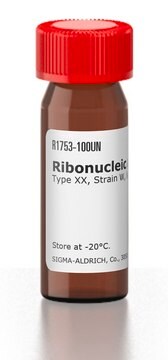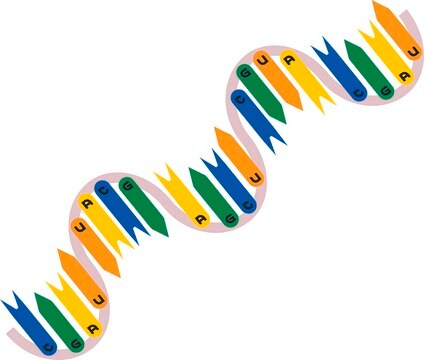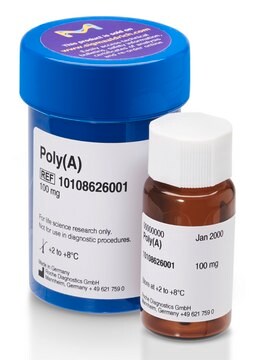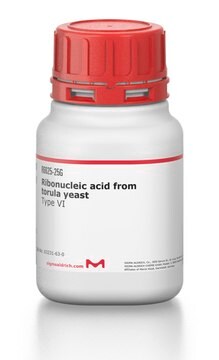R4752
Ribonucleic acid, transfer from bovine liver
Type XI, lyophilized powder
Sinonimo/i:
Transfer RNA, tRNA
Autenticatiper visualizzare i prezzi riservati alla tua organizzazione & contrattuali
About This Item
Prodotti consigliati
Cerchi prodotti simili? Visita Guida al confronto tra prodotti
Categorie correlate
Descrizione generale
Transfer ribonucleic acid (tRNA) is a non-coding RNA. It is approximately 70-100 base pair long. It has a cloverleaf shaped secondary structure. It has three or four arms and a stem structure. It has minor bases like pseudouridine, dihydrouridine and methylated bases in its structure. It has a binding site for triplet nucleotide sequence and for amino acids.
Applicazioni
Ribonucleic acid, transfer from bovine liver has been used:
- to analyze the efficiency of thioflavin T (ThT) as a fluorophore
- to test its ability to inhibit the growth of endothelial cells
- as a component in translation mixture
- as a non-specific competitor RNA for protein purification studies using poly(A) tailed RNA affinity column
Ribonucleic acid, transfer from bovine liver may be used as a starting material for the purification of specific amino acyl-tRNA species by methods such as liquid column chromatography or high-performance liquid chromatography (HPLC).
Azioni biochim/fisiol
Transfer ribonucleic acid (tRNA) plays a major role in translation, a key step in protein synthesis. It decodes mRNA into protein. There are about 40-60 different tRNAs in a eukaryotic cell and fewer in bacteria. This depends on the degeneracy of the amino acid code. Each amino acid has a specific tRNA. tRNAs are charged with specific amino acid and carries them to the site of protein synthesis. It binds to the ribosome and directs the amino acid to the growing polypeptide chain. It also functions as a regulator of various biological processes. Mutations associated with tRNA is implicated in human diseases.
Definizione di unità
One unit will yield an A260 of 1.0 in 1.0 mL of water (1 cm light path).
Risultati analitici
This product is evaluated for amino acceptor activity using aminoacyl-tRNA synthetase and L-arginine
Codice della classe di stoccaggio
11 - Combustible Solids
Classe di pericolosità dell'acqua (WGK)
WGK 3
Punto d’infiammabilità (°F)
Not applicable
Punto d’infiammabilità (°C)
Not applicable
Dispositivi di protezione individuale
Eyeshields, Gloves, type N95 (US)
Certificati d'analisi (COA)
Cerca il Certificati d'analisi (COA) digitando il numero di lotto/batch corrispondente. I numeri di lotto o di batch sono stampati sull'etichetta dei prodotti dopo la parola ‘Lotto’ o ‘Batch’.
Possiedi già questo prodotto?
I documenti relativi ai prodotti acquistati recentemente sono disponibili nell’Archivio dei documenti.
Shujuan Xu et al.
Scientific reports, 6, 24793-24793 (2016-04-22)
RNA G-quadruplexes (G4s) play important roles in translational regulation, mRNA processing events and gene expression. Therefore, a fluorescent probe that is capable of efficiently recognizing RNA G-quadruplex structures among other RNA forms is highly desirable. In this study, a water-soluble
Molecular Biology of the Transfer RNA Revisited, 5-7 (2014)
Approaches for monitoring nuclear translation
mRNA Processing and Metabolism, 103-113 (2004)
RNA-Protein Interactions : A Practical Approach, 149-150 (1998)
From DNA to Protein: The Transfer of Genetic Information, 217-221 (1980)
Il team dei nostri ricercatori vanta grande esperienza in tutte le aree della ricerca quali Life Science, scienza dei materiali, sintesi chimica, cromatografia, discipline analitiche, ecc..
Contatta l'Assistenza Tecnica.






